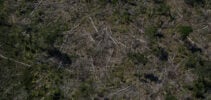➡️ Highlights:
- In addition to effects on climate, degradation can have major socioeconomic impacts;
- In projections for 2050, degradation factors, such as fire and illegal logging, will continue to be among the main sources of carbon emissions; It is
- One of the solutions could be the creation of an integrated monitoring system for forest degradation.
What does the study say?
For study (🇬🇧), researchers examined 4 degradation factors: fire impact, logging, drought and changes in habitat along the edges of the Amazon – what they called 'edge effects'. Most previous research on the Amazon ecosystem has focused on the consequences of deforestation.
ADVERTISING
The research found that fire, logging and edge effects have degraded at least 5,5% of all remaining forest in the region. Amazon, or 364.748 km², between 2001 and 2018. But when the effects of the drought are accounted for, the degraded area increases to 2,5 million km² or 38% of the remaining Amazon forest. 😔
“Extreme droughts have become increasingly frequent in Amazon as land use changes and human-induced climate change advance, affecting tree mortality, fire incidence and carbon emissions to the atmosphere,” the researchers said.
“Forest fires intensify during dry years,” they added, warning of the dangers of “much larger megafires” in the future.
ADVERTISING
Researchers at the State University of Campinas and other institutions used satellite images and other data from 2001 to 2018 to reach their conclusions.
In a projection made by the team for 2050, four degradation factors will continue to be the main sources of carbon emissions into the atmosphere, regardless of the growth or cessation of forest deforestation.
“Although it seems obvious, even in an optimistic scenario, when there is no more deforestation, degradation continues to be a factor in carbon emissions, mainly due to climate change”, he says David Lapola, researcher at CEPAGRI (Center for Meteorological and Climate Research Applied to Agriculture), at Unicamp and leader of the study. For the scientist, preventing the advancement of deforestation can contribute to more attention being directed to other factors of forest degradation.
ADVERTISING
The authors of the article propose the creation of a monitoring system for degradation, in addition to preventing and curbing illegal logging and controlling the use of fire.
One of the suggestions is the concept of “smart forests” which, just like the idea of “Smart cities” (smart cities), would use different types of technologies and sensors to collect useful data to improve the quality of the environment. “Public and private actions and policies to curb deforestation will not necessarily resolve degradation either”, assesses Lapola. “It is necessary to invest in innovative strategies”, he adds.
Read also
(🇬🇧): content in English
(*): Content in other languages translated by Google Tradutor
(🚥): may require registration and/or subscription




